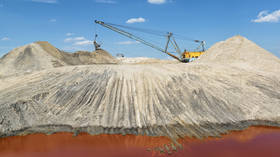‘Ostalgia’: Politics meets playfulness to put 2 sides to Berlin’s Wall legacy
Twenty-five years since the fall of the Berlin Wall, and people are nostalgic. But it's a specific condition manifesting itself in both, the city's creative flare, to calls for an even bigger wall.
In the background of the bustling metropolis that is modern, united Berlin, things like job security are gnawing at the population, while some claim they would even bring back the wall “10 meters higher.”
A number of people are pining for an East German, socialist past.
“East Germany was a democratic state, which allowed its citizens to live without fear for the future. No one had to worry whether they had enough to eat,” one man told RT. He may be counted among the one in nine Germans in favor of bringing back the wall, according to a survey by Berlin’s Free University.
“I’d have nothing against them rebuilding the wall and making it 10 meters higher. We’d at least have our job security and wouldn’t have to watch every penny,” another female respondent said.
The word often used to describe these sentiments is ‘Ostalgia’ – a mix of nostalgia and the German word ‘ost’ (east). This has caused some worry in political circles, including accusations by some that the media is attempting to paint post-wall life as one of togetherness and economic prosperity at a time when health, education and economic welfare are still top issues on the agenda that split the nation.

But it’s not all doom and gloom. As it turns out, it’s not just the older disgruntled generations, but youth as well, who keep things in focus – albeit with a much less political and more lighthearted and artistic way of reconciling themselves with the past.
Innocent-looking symbols of Eastern remnants – from little tourist trinkets to clothes, to even fake passport stamps – can be seen scattered throughout souvenir shops in Berlin as a naïve little bit of fun whose historical significance is easy to overlook amid all the comic flair for the creative.
One hotel can take you back 30 to 40 years, like a time machine, so you can bathe in the ‘glory’ of those days, from the furniture to the vintage equipment and overall ambience.
There is also a ‘nostalgia tour’ taking you around the German capital in a trusty old Trabant. Massive enthusiast for the car maker Rebecca Grosse admits the brand “wasn’t always iconic. After the wall came down people couldn’t wait to scrap them. But now we look on them fondly.”

The ability to experience Ostalgia has been ingrained in Berlin’s identity, with the number of visitors taking pictures by the rundown remnants of the wall and passing through Checkpoint Charlie – the most prominent east-west crossing in the city.
Even when one considers the city's controversial nightlife - all that 24-hour music and anti-establishment madness Berlin is known for, one often hears that the creative and sometimes controversial outbursts would not have been possible without a sudden rubber band effect that followed the fall of the wall.
For a closer experience of Ostalgia in modern Berlin, watch Peter Oliver’s report.















